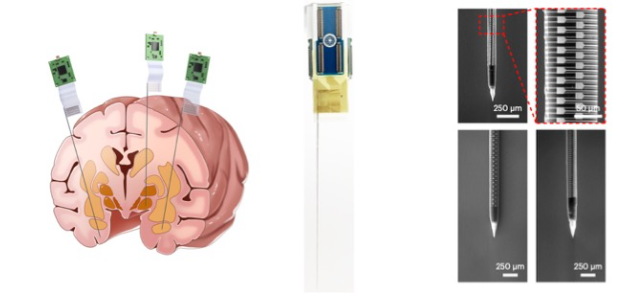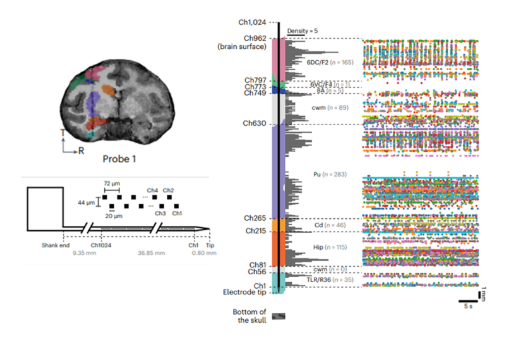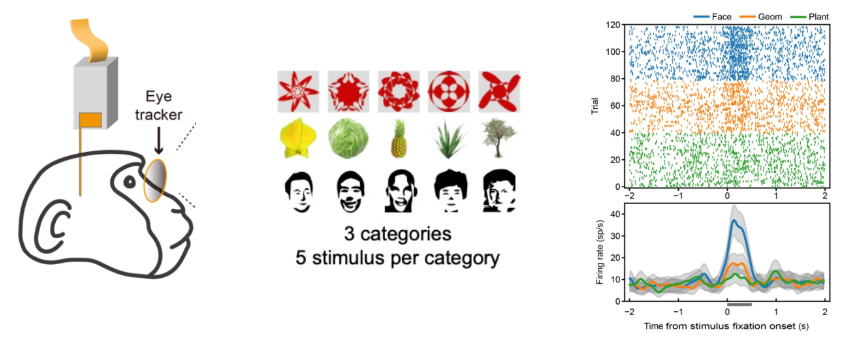Nature Neuroscience | A high-density 1,024-channel probe for brain-wide recordings in non-human primates
Source: Xiaojie Duan's Research Team
Recently, the research team led by Professor Xiaojie Duan from the Department of Biomedical Engineering at the College of Future Technology and the National Biomedical Imaging Center, Peking University, published a groundbreaking study in Nature Neuroscience titled "A high-density 1,024-channel probe for brain-wide recordings in non-human primates." The study introduced the Neuroscroll probe that isolates single neuronal activities simultaneously from 1,024 densely spaced channels that are flexibly distributed across the shank of the probe, representing a world-leading advancement.
The human brain contains tens of billions of neurons, prompting the development of high-resolution technologies for mapping brain activities. Neural probes, which can penetrate deeply into brain tissues to record electrical signals from single neurons, have broad applications in fundamental scientific research and clinical diagnostics. Non-human primates (e.g., macaques) are commonly used in neuroscience research, but existing neural probes for such animal face some limitations, including a low number of recording channels and restricted recording coverage, making it difficult to achieve high-throughput neural activity recordings across the entire brain depth.
In response to the above challenges, Professor Xiaojie Duan's team successfully developed a high-density, 1024-channel Neuroscroll probe (Figure 1). The team first designed and fabricated an ultrathin, flexible microelectrode array film. By employing a novel rolling assembly technique, they created the Neuroscroll probe with recording sites flexibly distributing across the probe surface, either clustered or uniformly, to meet diverse recording needs across multiple brain regions. The probe's length can be customized between 1 cm and 10 cm, accommodating brain sizes from rodents to primates.

Figure 1. The Neuroscroll probe for brain-wide neural recordings
In addition to the integration of the thousand channels onto a miniaturized shank, the connection between the probe and acquisition circuits is another major bottleneck for scaling neural probes toward thousands of channels. The team developed a high-density flexible cold bonding (FCB) method, enabling reliable electrical connections between the neural probe and components such as flexible extender boards, printed circuit boards (PCBs), and CMOS-based high-density microelectrode array chips. The modular structure of the Neuroscroll probes and the highly scalable, high-density FCB used for external connection makes them easily compatible with more advanced, miniaturized electronics with a small physical footprint.
Using this probe, the team achieved neural recording across the entire depth of the rhesus macaque brain (Figure 2). Under a fixation-saccade task, Neuroscroll probes of 90-mm length successfully detected visually responsive neurons from an awake rhesus macaque (Figure 3). In addition, the researchers implanted the probe into the prefrontal cortex of rats, achieving stable neural recordings for up to two years. During this period, the spike-sorted single-neuron counts, total firing rates, mean amplitudes of single units, number of channels with detected single units and signal-to-noise ratios remained stable, demonstrating the probe's excellent biocompatibility and long-term recording stability.

Figure 2. Neural recordings across the entire depth of the rhesus macaque brain using Neuroscroll Probe

Figure 3. Recording in an awake rhesus macaque under a fixation-saccade task
This high-throughput recording with brain-wide spatial coverage has many applications, such as simultaneously monitoring the inputs and outputs of diverse brain regions and assessing the relationship between behavior and activity across the brain. With the implantation of multiple probes, this technology has the potential to scale up to thousands or even tens of thousands of channels, providing great potential of Neuroscroll probes in a wide range of applications in fundamental and translational neuroscience studies.
In this work, Professor Xiaojie Duan is corresponding author. Dr. Liu Yang, Dr. Jia Huilin, and Dr. Sun Hongji are co-first authors. This work was supported by grants from the National Natural Science Foundation of China, the STI2030-Major Projects, the National Key R&D Program of China and the Natural Science Foundation of Beijing Municipality. The work also received significant support from Professor Yuji Naya at the School of Psychological and Cognitive Sciences, Peking University, Beijing, China and Professor Xiaojian Li at the Shenzhen Institutes of Advanced Technology, Chinese Academy of Sciences.




